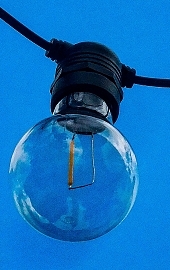Adam Yamey's Blog: YAMEY, page 122
June 22, 2022
Eyes facing the ocean from Madeira
STARING OUT TO sea at Calheta on the Portuguese island of Madeira is a bronze bust of a man wearing 18th century clothing and a bow tie. The sculpture depicts Sebastián Francisco de Miranda y Rodríguez de Espinoza (1750-1816). Born in Caracas in what is now Venezuela, Miranda became a military leader and a revolutionary fighting for his country’s liberation from Spanish rule. Regarded by many as the forerunner of Simon Bolivar (1783-1830), the great liberator of several Spanish South American colonies and born in Caracas, Miranda ended his life in a Spanish prison in Cadiz.
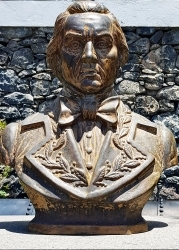
The plaque below the bust in Calheta records (translated from the Portuguese on a website: https://statues.vanderkrogt.net/object.php?record=ptma108):
“The Sons of the municipality of Calheta in the lands of Venezuela at the bicentenary of the Independence in honour of its precursor ‘Generalisimo, Sebastian Francisco de Miranda’ ‘The most universal Venezuelan’”
I interpret this as meaning that the bust was erected by descendants of people from Calheta, who had emigrated to Venezuela.
The bust was created by the Venezuelan sculptor Julio César Briceño Andrade, who was born in Caracas in 1950. It was unveiled in Calheta by Lucas Rincón Romero, the Venezuelan Ambassador to Portugal, on the 5th July 2011.
Miranda was the son of a man, who had migrated to Venezuela from the Spanish Canary Islands. His mother was born in Venezuela. Although, he crossed the Atlantic several times, I do not know whether Miranda ever set foot on the island of Madeira.
Like those from Calheta, who migrated to Venezuela, many others have migrated from Madeira to various parts of the world over the years. I have been told that many of the Portuguese speakers in South Africa had their roots in Madeira. Having seen the bust in Calheta, clearly Venezuela was another destination.
Now, with difficulties that Venezuela has been facing, some its citizens with Madeiran heritage are returning to the island as can be seen in an article published on-line (www.euractiv.com/section/global-europ...
“No one knows the exact figure but the authorities in Madeira consider that about 6,000 Venezuelans of Portuguese descent have taken refuge on their island, where they found themselves in an extremely precarious situation. “They arrive with nothing, many are sick, these are people lacking a great deal,” said the President of the Portuguese archipelago, Miguel Albuquerque. These people are second or third generation Portuguese, descendants of those who left Madeira decades ago in search of a better life in Venezuela. They are now making the opposite journey.”
Reading this made me think about South Africa, to which many Europeans, including my parents’ families, travelled in search of a better life. After the ending of apartheid, many of their descendants have left the country because they had become concerned about their futures in a land where Europeans no longer hold the upper hand.
June 21, 2022
A giant aircraft in Lisbon
WHILE AWAITING TAKE-OFF from Lisbon’s main airport, our aeroplane was ‘parked’ beside the largest aircraft I have ever seen. Operated by Maximus Air Cargo company, its nose was pointing upwards towards the sky. It was being loaded with freight through an enormous aperture at its front end. The aeroplane was so large that it dwarfed the numerous workers around it and the forklift trucks being used to load its cargo. Even the Airbus 320 craft standing nearby seemed tiny in comparison. As we had to wait for what seemed like ages before we taxied to the runway for take-off, I had plenty of time to stare at it and to take photographs through the window next to my seat. My curiosity increased when I observed that the ‘plane had its make written on the raised section of its nose: Antonov 124-100.

The Antonov aircraft were built mainly during the years that the Soviet Union was in existence. The company that built these freight carrying ‘planes is named after the aircraft designer Oleg Konstantinovich Antonov (1906-1984). Born in the Moscow region, he was the son of a civil engineer. From 1923 onwards, he was deeply involved in aircraft engineering and design. By 1938, he was the leading designer in the aircraft plant headed up by AS Yakovlev (www.antonov.com/en/biography). And in May 1946, he headed up his own aircraft design plant, based in Novosibirsk. By 1948, ‘planes designed by Antonov and his team were being manufactured in Kiev (Kyiv in what is now Ukraine). In 1952, Antonov and his design bureau moved to Kiev. Antonov’s team began designing the AN 124 heavy transport aircraft in the early 1970s. The AN 124’s maiden flight was in 1982, but the vehicle only became known to the world at large when it was exhibited at the Paris Air Show in 1985. The AN 124s were produced at two factories: one in Ulyanovsk (now in Russia) and the other at Kiev (now in Ukraine). One special feature of the AN 24’s design is that its landing gear with 24 wheels is designed both for landing on rough terrain and to enable the ‘plane to kneel down so that its front entrance can be lowered to make loading and unloading easier. About 55 of the AN 124 craft were built between 1982 and 2004. According the uk.flightaware.com website, the AN 124 (registration UR-ZYD), which we saw on the 17th of June 2022 had flown from Leipzig to Lisbon that day and was about to fly on to Cairo (Egypt). It flew to Kigali (Rwanda) from Cairo on the 18th of June. Another website ( www.planespotters.net/airframe/antonov-an-124-ur-zyd-maximus-air-cargo/ejn4jx) revealed that UR-ZYD was built just over 18 years ago, in about 2013/14, making it one of the last to be built.
Maximus Air Cargo, which operates the AN 124, which I saw, is an Abu Dhabi based company, which specialises in transporting larger than usual objects. The company owns one Antonov 124-100, about which its website (www.maximus-air.com/fleet/antonov-124...) noted:
“The heaviest of the heavyweight cargo lifters. It has a unique self-contained multiple winch and overhead crane system capable of self loading / unloading 120 tonne from front or rear. Can carry 21x Toyota Land Cruisers or 4 x Mi 17 MTV Helicopters without breaking a sweat.”
The aircraft’s maximum range is 6710 nautical miles (‘nm’), but when it is carrying its maximal pay load (120,000 Kg), this reduces to 2420 nm.
I had heard of the Antonov aircraft before, but the example I saw in Lisbon is the first I have seen ‘in the flesh’. I found that seeing this giant was very exciting.
June 20, 2022
A glass globe
June 19, 2022
Black and white beneath your feet
WHEN WALKING IN central Funchal, it is worth looking down at the pavements. Like those in Lisbon and other towns in Portugal, their surfaces are covered with small black and white stones arranged to create pleasing patterns. I imagine that these compositions created using irregularly sized stones must be laid by hand rather than by using a machine.
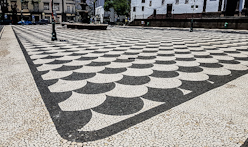 Funchal
Funchal Often the stones are laid on the pavements as well as on large
open spaces in such a way that fascinating optical effects are achieved. By making
such lovely places on which to walk, the cities and towns become beautiful in whichever
direction you look.
June 18, 2022
Rum and cane in Madeira
CALHETA IS A COASTAL town in Madeira about 1.5 hours drive west
of the capital, Funchal. We went there for an outing to see something of Madeira
away from its capital. While there we saw an interesting factory-cum-museum.
The island of Madeira was once a major producer of sugar cane. Some of the work was performed by black slaves, but unlike other places such as Brazil, the slaves in Madeira tended to be ‘employed ‘ as domestics and builders. Today, sugar cane is till grown in Madeira, but the workers are local Madeirans.
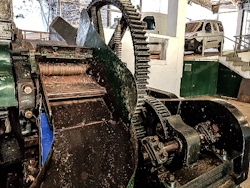 Cane pressing machinery in Calheta
Cane pressing machinery in CalhetaIn Calheta,there is an enterprise called Sociedad dos Enghennos da Calheta. This is a factory where sugar cane is crushed between rollers to extract the sugar cane juice. The juice is fermented in the factory to produce rum. It is also processed to make molasses. The place also makes traditional Madeiran cake called Bolo de Mel and soecial biscuits. All of these products can be sampled and bought at the factory. Visitors are free to wander around the factory and its attached museum, which contains a fine collection of vintage industrial machinery.
As with other museums we have seen in Madeira, the exhibits are
well displayed. Although the main attraction of Calheta is its sandy beach – the
only one in Madeira: it is created using sand imported from North Africa, the rum
and cane factory/museum is well worth a visit.
June 17, 2022
A lady from Lichtenstein
FUNCHAL IN MADEIRA is famed for its glorious gardens, which can be visited by members of the public. Actually, the whole city is filled with so many flowering plants and trees that it is almost like a huge garden. Nevertheless, we decided to see one of the gardens for which the city is known. We chose the Palheiro Gardens, which are located about 500 metres above sea level.
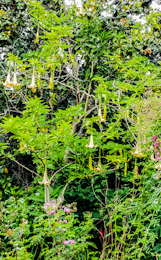
To reach the gardens, we took local bus number 37 from the
Pingo, a square near the Mercatos Lavradores.
While waiting for the bus to depart, we began chatting with another passenger,
a lady who spoke English with a Germanic accent, who last visited the Palheiro
18 years ago. It turned out that she is from Lichtenstein. As far as I can
recall, she is the first person from that tiny country next to Switzerland with
whom I have ever spoken.
The bus trip up to the Palheiro is spectacular. The road
winds ever upwards along the edges of deep ravines. As the road ascends, there
are many dramatic views of Funchal and its bay.
The gardens are well-tended and are laid out in a seemingly
informal way, in the English garden style. The gardens flourish on slopes
overlooking the city far below and a golf course nearby. I do not know enough
about trees and flowers, but suffice it to say that the place provides a
colourful feast for the eyes.
The Palheiro gardens are laid out in the former estate of the
wealthy Count of Carvalhal. The place was purchased in 1885 by the Blandys, a
family of British entrepreneurs, bankers, makers of Madeira wine, and merchants
who have been important in the development of Madeira’s economy. Part of the
gardens retain features laid out by the Count in the 18th century,
but much of the rest of the grounds have been developed since then.
Being at about 500 metres,
the garden is noticeably cooler than in the centre of Funchal. In fact, during our visit, we were close to
the clouds and occasionally felt the moisture contained within them. I am
pleased that we visited the Palheiro, but feel that given the profusion of
lovely plants all around Funchal, I wonder whether visiting gardens like this
one is a ‘must do’ activity unless you have a special interest in gardens and
gardening.
The journey between Funchal and Palheiro and my first
meeting with a person from Lichtenstein enhanced my trip to the gardens.
June 16, 2022
Where fishermen once lived
FUNCHAL IN MADEIRA is a place well suited for unhurried exploration. At first, I was worried that 11 days might be too long for a stay here, but this is not the case: it is far too short. There is plenty to see and do without queuing for the famous cable car or for the toboggan ride down a steep road. There are interesting museums to see, but a great deal of pleasure can be derived from wandering leisurely around the older parts of the place.
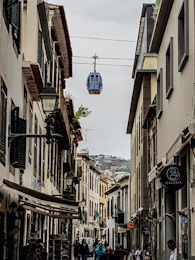 Cable car passing above Zona Velha in Funchal
Cable car passing above Zona Velha in Funchal One area, which despite being rather ‘touristy’, is the Zona
Velha. East of the old patrician areas around
the cathedral and the university, the Zona Velha used to be the poorer part of
the city, where fishermen and their families lived in rather narrow crowded
streets near the seashore and the venerable Forte São Tiago. This fortress was one of a chain of four or
five forts that used to protect Funchal from seaborne attackers.
The streets of the Zona Velha have become trendy and there has
been a conscious attempt to make the area bohemian. Many of the doors have been
painted with often entertaining designs and pictures. There are plenty of small
bars and restaurants, but we were
advised by some ladies who work in a museum that these tend to be of poor
quality and are best avoided.
High above the Zona there is a terrace overlooking a sea
bathing area. Near this, there is an old church, the Igreja de Santiago Menor,
which was closed when we visited the district. The café next to the terrace
provided excellent coffee at a surprisingly reasonable price given the
wonderful sea view from its tables: we paid 3 Euros for two coffees and a
pastry.
As touristic areas go, the Zona Velha is certainly worth strolling
through. It is probably best to go there earlier in the day before the roads
are filled with tables and chairs next
to the eateries.
June 15, 2022
On a very steep street
WE CAN EITHER travel into the centre of Funchal by bus or walk. From our guesthouse, the steep Caminho do Monte drops steeply down to the city centre. Most of the way, this almost a mile long thoroughfare has a gradient of 40 to 45 degrees. Walking down this slope does wonders for one’s lower leg muscles, especially the calves. The first time we descended it, my calf muscles began to go into tremor.
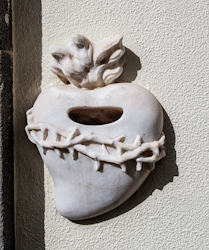 A Sacred Heart
A Sacred HeartOur next attempt was altogether easier. On the way downhill, we passes a religious institution: a seminary called Colégio Missionário Sagrado Coração. Being Sunday, the gates were open for people who wanted to attend the Sunday mass. The institution is named in honour of the Sacred Heart. On either side of the door leading into the simply decorated chapel, there are car ings of hearts encircled by thorns.
There is a sculpture of a lion in the place’s large courtyard. Two busts of important religious figures stand near the chapel. One of them stsnds close to a terrace from which a wonderful view of part of Funchal can be enjoyed.
Although walking down the incredibly steep slope is slow, it is a wonderful way to observe deatails of life on the hills high above Funchal, and to meet locals standing on terraces over the road or in the entrances to their homes.
June 14, 2022
A museum in Madeira
HOUSED IN AN OLD palace, the Quinta das Cruzes museum (‘Quinta’ for short) contains a collection of exhibits of various kinds and its beautiful garden has a small collection of archaeological architectural fragments. In a way, the Quinta is Funchal’s version of London’s V & A, but much smaller.
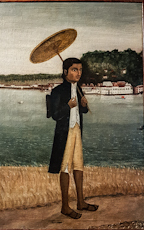 Goa long ago
Goa long agoThe much remodelled building housing the museum was initially built for João Gonçalves Zarco (c 1390 – 1471), who was the ‘discoverer’ and first Captain (i.e., governor) of Madeira. I am not sure how much of what Zarco would have seen in his time can be seen today. Nevertheless, it is an attractive edifice.
Several exhibits particularly interested me in the museum. One was a retable, a triptych, carved intricately in ivory. To our surprise, we discovered that this was an English production, created in the 19th century.
There were several fine paintings of Madeirans and their island painted by English artists including Eliza Eleanor Murray, Charles Scott-Murray, and Thomas Butterworth. The paintings by Murray and Scott-Murray were late 18th century. These pictures hung in rooms alongside English furniture including pieces by Chippendale and Sheraton.
Another exhibit that attracted me was a fine embroidery on which wild animals are depicted. This was produced in Portuguese Macau for a Christian religious order: the Carmelites.
Another former Portuguese colony, Goa on the west coast of India, is represented in the museum by three attractive paintings showing people and scenery in Goa in the 18th or 19th century.
These exhibits from what is now China and India remind us of Portugal’s pioneering and extensive colonisation of the world beyond Europe. The artefacts from the UK and by British artists recollect the importance of Madeira in the history of British trade and tourism.
I have outlined a few of the exhibits that are on view in the museum, but there is plenty more to enjoy including a grest collection of fine silverware (including models of serving women with black faces) and a very elegant modern refreshment area. It overlooks a fine panorama of part of Funchal.
Along with the Museum of Sacred Art, the Quinta is one of the cultural highlights of Funchal.
June 13, 2022
Roof ornaments in Funchal, Madeira
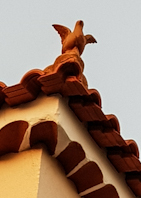
MANY ROOFS IN FUNCHAL are covered with terracotta tiles. Quite a few of these roofs have small sculptures on their corners. Many of them depict heads, birds, and scrolls ( leaves?) I have no idea why these things are added to the roofs.
Someone suggested that these ornaments are supposed to deter mice, squirrels, and birds. Maybe, they are for that purpose. In India ornaments depicting ogre’s faces (‘rakshasa’) are atteched to roofs to ward off the Evil Eye. Possibly, this is a finction of the ornaments I have seen in Funchal. Another possible function of these roof ornaments (finials) might be to distinguish one house from another. However, I am not sure about this here in Funchal because there is little variety in the firms used.
I would love to know more about them: their purpose and history.

